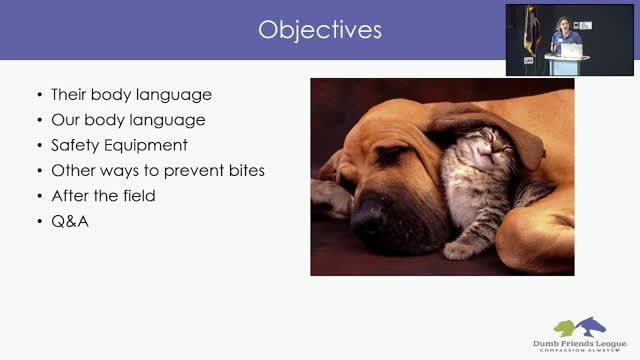Understanding Dog Body Language to Prevent Bites
November 20, 2024 | Agriculture, Governor's Cabinet, Organizations, Executive, Colorado
This article was created by AI summarizing key points discussed. AI makes mistakes, so for full details and context, please refer to the video of the full meeting. Please report any errors so we can fix them. Report an error »

In a recent government meeting focused on animal welfare, experts provided valuable insights into understanding canine body language, emphasizing the importance of recognizing subtle behavioral cues to prevent potential aggression and enhance human-animal interactions.
The session began with a discussion on the significance of observing an animal's body language, which can convey a wealth of information about its emotional state. Attendees were encouraged to pay attention to various aspects, including the position of the dog's body, the expression in its eyes, the posture of its ears, the state of its mouth, and the movement of its tail.
Key points highlighted included the notion that a dog's behavior is fluid and can change rapidly based on environmental factors and interactions with other animals. For instance, a dog approaching with a relaxed posture may curve its body rather than approaching head-on, indicating a non-threatening demeanor. Conversely, a dog displaying a full-frontal stance may be signaling discomfort or aggression.
The discussion also delved into the nuances of canine eye expressions, with experts explaining terms like \"whale eye,\" which refers to a dog showing the whites of its eyes—a sign of anxiety or fear. Similarly, the position and movement of a dog's ears can indicate its emotional state, with pinned ears often signaling fear or aggression.
Attendees learned that a dog's mouth can also reveal its feelings; a relaxed mouth may indicate comfort, while lip licking or yawning can be signs of stress. The session emphasized the importance of interpreting these signals in conjunction with the dog's overall body posture to avoid misreading its intentions.
The tail's position and movement were also discussed, with experts cautioning that not all tail wags signify happiness. A high, stiff wag may indicate tension, while a low wag could suggest fear. Interestingly, the direction of a dog's wagging tail can also provide insights into its emotional state, with right-side wags generally indicating happiness and left-side wags suggesting anxiety.
The meeting concluded with a call for awareness regarding modifications that can affect a dog's ability to communicate, such as ear docking and tail removal, which can hinder their natural body language. Participants were encouraged to remain vigilant and considerate of these factors when interacting with dogs, particularly in shelter environments.
Overall, the meeting underscored the critical role of understanding canine body language in fostering safe and positive interactions between humans and dogs, ultimately promoting better welfare for animals in shelters and beyond.
The session began with a discussion on the significance of observing an animal's body language, which can convey a wealth of information about its emotional state. Attendees were encouraged to pay attention to various aspects, including the position of the dog's body, the expression in its eyes, the posture of its ears, the state of its mouth, and the movement of its tail.
Key points highlighted included the notion that a dog's behavior is fluid and can change rapidly based on environmental factors and interactions with other animals. For instance, a dog approaching with a relaxed posture may curve its body rather than approaching head-on, indicating a non-threatening demeanor. Conversely, a dog displaying a full-frontal stance may be signaling discomfort or aggression.
The discussion also delved into the nuances of canine eye expressions, with experts explaining terms like \"whale eye,\" which refers to a dog showing the whites of its eyes—a sign of anxiety or fear. Similarly, the position and movement of a dog's ears can indicate its emotional state, with pinned ears often signaling fear or aggression.
Attendees learned that a dog's mouth can also reveal its feelings; a relaxed mouth may indicate comfort, while lip licking or yawning can be signs of stress. The session emphasized the importance of interpreting these signals in conjunction with the dog's overall body posture to avoid misreading its intentions.
The tail's position and movement were also discussed, with experts cautioning that not all tail wags signify happiness. A high, stiff wag may indicate tension, while a low wag could suggest fear. Interestingly, the direction of a dog's wagging tail can also provide insights into its emotional state, with right-side wags generally indicating happiness and left-side wags suggesting anxiety.
The meeting concluded with a call for awareness regarding modifications that can affect a dog's ability to communicate, such as ear docking and tail removal, which can hinder their natural body language. Participants were encouraged to remain vigilant and considerate of these factors when interacting with dogs, particularly in shelter environments.
Overall, the meeting underscored the critical role of understanding canine body language in fostering safe and positive interactions between humans and dogs, ultimately promoting better welfare for animals in shelters and beyond.
View full meeting
This article is based on a recent meeting—watch the full video and explore the complete transcript for deeper insights into the discussion.
View full meeting
